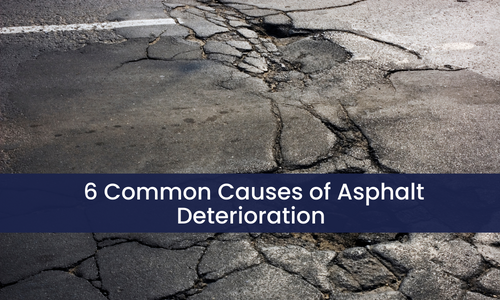If installed and maintained by an experienced Houston professional, asphalt pavement will last for decades. If there are issues with the pavement’s installation, though, asphalt will soon show signs of damage. And, of course, weather and wear will also cause asphalt paving to deteriorate over time.
If your asphalt surface is starting to fail, these are common signs to look for:
- Cracks
- Potholes
- Depressions
- Warping
- Raveling and loss of surface texture
- Discoloration
While the above signs of damage may be obvious, the underlying cause may not be. Asphalt damage can result from any number of stresses. Let’s look at each cause so you know what you’re looking at in terms of repairs.
Base, subbase and subgrade failures
The base is what sits under the pavement’s surface layers, and the subgrade is the soil that sits below that. Both layers are important for the pavement’s long-term performance and wear characteristics. However, a lot can go wrong when installing the base and subbase. The pavement team must consider the following factors:
- The soil’s composition
- The soil’s density
- Loading conditions
- Weather conditions
- The type of pavement being installed
- The pavement’s thickness
And there are many more. If the pavement team doesn’t properly sample, analyze and compact the soil prior to installation, it will eventually destabilize. This will place additional stress on the top pavement layers, resulting in severe cracking and potholes.
If your pavement’s base has failed, the only fix is to cut around the failed areas, compact and stabilize the base, tack it, then roll hot asphalt over it.
Overloading and Poor Bearing Capacities
Pavement is installed with specified loadbearing limits in mind. The loadbearing characteristics of a parking lot, for example, are different that those found on an interstate. If the pavement is subjected to overloading, it can cause failures throughout the entire pavement’s depth.
For example, if your property sees a lot of heavy truck traffic, those trucks could cause shoving or rutting. Shoving appears as raised bumps on the asphalt’s surface, while rutting creates ripple-like channels or ruts that run in the same direction as traffic.
Alligator, or fatigue, cracking is also common when overloading is present. Fatigue cracking emerges in a spiderweb or shattered glass-like pattern and is usually caused by a combination of water intrusion and repeated heavy loads.
In all of these cases the compromised area will need to be cut out and replaced once the base has been repaired.
Old Cracks and Damage That Haven’t Been Addressed
Once your asphalt hits the 10-year mark, asphalt experts recommend an overlay. During overlaying, a new surface layer of asphalt is rolled out over the existing pavement. It’s an effective, life-extended form of maintenance that restores performance, durability, and appearance.
Before the overlay is installed, though, any base failures and extensive cracking must be addressed. If they are not, the new overlay will soon develop the same crack patterns. In this way, the cracks are reflected in the new asphalt – which is where the term comes from.
If your parking lot, street or driveway have already received an overlay, then any new damage may be the result of deeper, unrepaired flaws.
Oxidation
As soon as asphalt is rolled out, oxygen starts affecting it. Specifically, it attacks the asphalt binder that holds the surface aggregate together.
Over time, the binder will deteriorate to the point where the asphalt loses its rich black color. Also, surface aggregate may loosen, detach, and gather on the pavement’s surface. This is known as raveling, and if not addressed, it will expose the asphalt’s deeper layers and increase the likelihood of water damage.
Think of raveling and discoloration as the first signs that maintenance is required. In this instance, asphalt crews will sealcoat the pavement. Sealcoat is made from an asphalt emulsion that’s applied to the pavement’s surface. It’s like a coat of finish that restores the pavement’s look, surface texture and integrity.
Weather and Thermal Stresses
Asphalt is designed to hold up under the elements, but extreme weather events and thermal stresses can cause failures. When the heat’s on, the asphalt and underlying soils will expand. When it cools off, asphalt and soil contract. Asphalt is flexible and can handle most thermal stresses, but if the soil expands too much, it can cause upheaval.
Upheaval causes uneven asphalt, and it’s common for raised areas to be broken and separated from the surrounding pavement. Removing and replacing the asphalt is the only option in this case.
Poor Drainage and Water Intrusion
Along the Gulf Coast, Texas black clay soils are found everywhere. This soil is nearly impermeable and therefore is an aquitard – a substance that slows the flow of water.
Sufficient and efficient drainage is needed on any property that sits on expansive black clay soils. Without it, water will back up onto the property and possibly onto paved areas. Constant water exposure is a major problem for asphalt binder and will open up cracks in the surface. Once that occurs, water will penetrate into deeper layers and destabilize the base – leading to potholes, blowouts and potential sinkholes.
Asphalt is a Durable Material When Handled by an Experienced Houston Pavement Contractor
Poor installation, lack of maintenance, weather, water and loading conditions can all compromise asphalt. Again, though, the material offers excellent durability as long as it’s installed and maintained properly. When property owners are proactive with their pavement maintenance, asphalt will provide an excellent return on investment. The trick is knowing when damage is emerging and what to do about it.
- HOA & Condos – How Asphalt Pavement Can Affect Your Houston Property Values - March 6, 2025
- What Certifications or Licenses Should a Houston Asphalt Contractor Have? - September 17, 2024
- Common Challenges in Concrete Construction - September 11, 2024

